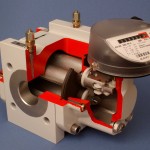
A reader contacted me to say that he had a gas meter on his site that runs backwards when there is no demand. It is a rotary positive-displacement type (see picture) and I believe it is one of a number of sub-meters on what I know to be a sprawling industrial complex. His first thought had been that the gas in the downstream pipework might be warming up and expanding, pushing back through the meter, but a quick calculation showed that this would only account for about 10% of the observed volume. We established that the meter was in the right way around, and had mechanical as well as digital readouts, which tallied with each other. I put the puzzle to the readers of the Energy Management Register to see what they thought. I got about twenty responses and here is an edited summary of what came back.
A few people asked questions and suggested some measurements that might be useful: for example wanting to know what sizes and types of equipment were on the network, and what the standing pressures were upstream and downstream of the meter (it can only run backwards if the downstream pressure is higher than upstream). One theory was that there is something pressurising the downstream side. This is not completely fanciful and one reader on a similar site mentioned that he had gas supplies at both ends, one of which had been capped off. A long-forgotten redundant but imperfectly-isolated second mains supply could easily be the culprit. On a big network it would feed back through the meter and into other branches if there is even the slightest pressure differential.
Another reader asked if there were any gas booster sets downstream of the meter, fitted to increase gas pressure above that of the supply main on high-output burners. When the burners shut off, any residual pressure could dissipate via a defective non-return valve back through the meter.
A lot of respondents asked no questions but fired off some inspired suggestions. One raised the possibility that groundwater was leaking into buried pipework and displacing gas. It would not need to be very deep for this to happen but presumably there would be obvious and dramatic consequences whenever the burners fired up after a prolonged idle spell. Several raised the possibility that air was being pumped in somehow — which could create a gas mixture that could detonate rather than ignite when next called on.
Other readers focussed on the upstream gas pressure and the possibility that something might be causing it to drop. For example, it might be cooling down during periods of no demand. If the upstream pipework is extensive this could draw back a larger volume via the meter than expansion downstream but this would have only a temporary effect, and only when other branches were not drawing gas. Two or three people raised the possibility that there were gas booster sets in the other upstream branches and that the suction from those would depress the upstream pressure. Indeed one reader had seen exactly this effect trip out a CHP plant on low pressure. Two ingenious folk suggested a Bernoulli effect, in which the problematic supply is teed off from a main and high-velocity gas passing the junction sucks gas from the branch.
One reader thought that the meter ought to be fitted with a ratchet to stop it turning backwards; I think this is normal with fiscal meters for obvious reasons, and it is not a bad point. If you stall a gear meter like the one in question, it stops the flow, and as there are safety implications in many of the ideas put forward, that seems like a good idea.
At the time of writing we are waiting to find out what was discovered. Meanwhile thanks to Bill Gysin, Mike Mann, Mike Muscott, Andrew Cowan, Vic Tuffen, Ben Davies-Nash, Jeremy Draper, James Pollington, John Perkin, Alan Turner, Bill Spragg, Mike Bond, Jonathan Morgan, James Ferguson, Neil Howison, Ian Hill, Tony Duffin, Neil Alcock, Peter Thompson and others for your insights.